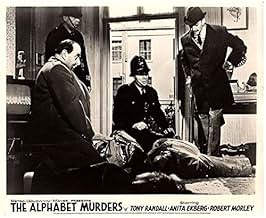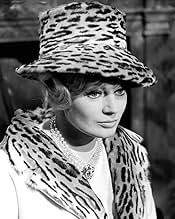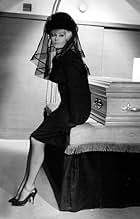Ajouter une intrigue dans votre langueHercule Poirot investigates a series of murders in London in which the victims are killed according to their initials.Hercule Poirot investigates a series of murders in London in which the victims are killed according to their initials.Hercule Poirot investigates a series of murders in London in which the victims are killed according to their initials.
- Réalisation
- Scénario
- Casting principal
Avis à la une
First, the form of the thing: in key plot elements, it is a rather close adaptation of a Christie book where a murderer "tells a story" in his murders in order to throw the police off. So it begins by being a story about fooling the detective inside another story (the movie) about trying to fool us as detectives.
The clue is about words. As a mystery, it is one of the clever explorations that Agatha had, looking at every way she could legally twist the convention of the form.
The tone of the thing is what is at issue. Peter Sellers had just had a hit with "Pink Panther" as a bumbling French detective and Poirot inherits some of this. Christie intended for him to be comic in a pompous way, and to varying degrees played with the tension between his genteel buffoonery and his sharp mechanical mind. It was not a simple joke, because her goal in part was to both describe and comment on how such an interesting mind would work.
She explored this indirectly by describing his manner, his minor superstitions, his attention to domestic ritual, the vanity of the perfect phrase, whether as a thought or a courtesy. She couldn't do that with Marple, who was as sharp but whose mind and manner was crass and impolite.
So part of the game for me in watching film versions is in how the adapter treats the relationship with the viewer so far as the mystery proper. There are all sorts of narrative mechanics that are involved there than aren't worth mentioning now. The other part is in how the mind of the detective is portrayed, and since we can only see the mind through the story (as I just said) and in the person's manner, that manner is key.
I think I liked this Poirot better than any of the others. They're all comic in one way or another, and this one seems further in tone from what was written. It is, but it may be closer in intent even though its in a context of Jerry Lewis slapstick.
Consider this: in mystery your mind and the detective's are supposed to parallel each other in important ways. In creating a version of the story -- the truth -- despite attempts to force it others wise, you both do this. So in fact, you create the world itself in a way. Some of the basic mechanics are frozen in life as in the genre, but others are completely open for you both to make: matters of how clever fate is, how comic are the wheels of nature, how inevitable is justice, what justice means, how conscience and consequence matter.
If the filmmaker can harmonize the tone of what you as viewer see and create in your own mind of the world, with what your surrogate the detective does, then he has succeeded and you can enter the movie whole.
This movie seems trivial. I think it is all but impossible to see. But it succeeds with its Poirot where no other attempt does.
Ted's Evaluation -- 3 of 3: Worth watching.
A disaster and a betrayal of the author .
The story concerns murders that seem to follow the alphabet, as Poirot pursues a beautiful blonde (Anita Ekberg) with the initials ABC, believed to be the killer. There are a lot of chase scenes and some slapstick, and poor Robert Morley as Hastings trying to keep track of Poirot.
This film was intended to follow up on the success of the Miss Marple movies starring Margaret Rutherford - in fact, Rutherford as Marple and her real-life husband, Stringer Davis, who plays her friend in the films, actually appear in one scene. While Rutherford's characterization has nothing to do with the Christie Miss Marple, it was successful on its own merits. The same can be said for the Hercule Poirot of Peter Ustinov -- absolutely delightful but has nothing to do with Christie's character.
I have seen Albert Finney, David Suchet, Ustinov, and Ian Holm do Poirot. Finney was very good, Suchet perfection, Ustinov discussed above, and Holm very funny (he plays Poirot in "Murder by the Book" as he reads Christie's final novel about himself). Randall does the role with a light touch, but with several different accents - French, British, and American. He has Poirot's vanity and arrogance as well. Perhaps seeing this film when it was made, his performance comes off as better, but seeing it today after a history of better Poirots, it just doesn't come off, though Randall was a wonderful actor.
The script isn't as good as the Rutherford scripts. Still, "The Alphabet Murders" is enjoyable enough. Just don't read the book, and forget it's Agatha Christie, and you'll have a good time.
The film begins with Randall introducing himself as Poirot with a twinkle in his eye. The director is clear from the first scene--comedy first, mystery next.
Robert Morley is fun, but Randall is even better--the bowling alley, the restaurant gags, the telephone calls--all scenes filled with visual, good humor rather than slapstick. Morley depends on the typical British attitudes, e.g., snapping fingers down the pecking order, jumping queues and not knowing one's shoe size all depicting arrogance of society and wealth. Director Tashlin dishes out a comedy with considerable social comment--Brits who cannot differentiate the French from the Belgian French and are in the police force!
The most intriguing bit was to introduce Margaret Rutherford as Miss Marple and Stringer Davis as Mr Stringer of the Miss Marple films bump into Randall's Poirot briefly. Surely this was a gem of an idea from Tashlin.
The film cannot be easily trashed--it offers comedy and entertainment, nearly 40 years after it was made. It is definitely not the definitive Poirot but an interesting interpretation of Poirot. It is probably one of the best Randall films ranking alongside "The Seven Faces of Dr Lao."
Tony Randal is an acquired taste as Poirot, almost getting up your nose with an abysmal accent and acting as if he's the only one with grey cells, and overdoing that. The constant referring of him as a 'short' Belgian is the biggest mystery, as he's taller than most in the film. Poor Robert Morley tries his best, but the tedium of the film mainly comes from the rather repetitive score. Plotwise it doesn't really test the viewer, but enough is happening to keep you guessing. 30 seconds of Margaret Rutherford and spouse puts a much needed grin on the face, but it's not enough by far.
Certainly one to add to the collection, but don't rush for it at the garage sale. Overall, a huge waste of talent. Pity.
Oh, and a reviewer thinks Finney's Poirot was a masterpiece? Yeah. Right.
Le saviez-vous
- AnecdotesThe official screenwriters of this movie, David Pursall and Jack Seddon, were greatly annoyed by the extensive re-writing of their script by Director Frank Tashlin and Robert Morley. Tashlin also encouraged Morley and Tony Randall to ad-lib lines and business.
- GaffesFor the swimming pool murder, when the dart is fired, the view is from behind the murderer and one can plainly see the gun is aimed below and to the right of the victim. Then in the close-up of the victim, the dart is positioned on the left side of his neck as if it had been fired from his left, not mainly from his front. In any case, it is a very unlikely shot with a dart pistol from such a long range.
- Citations
Hastings: Where have you been? What have you been doing?
Hercule Poirot: Arranging a little extra insurance my friend.
Hastings: Oh really? Personally I always feel perfectly safe with British railways. Mind you its very different in France, isn't it?
Hercule Poirot: I wouldn't know. I am not French, I am Belgian.
Hastings: Well it's the same thing, you both eat horsemeat.
- Crédits fousTony Randall emerges from Borehamwood Studios' Stage 4 to introduce the film and acknowledge his own starring credit, first as himself and then in full Poirot make-up and character.
- ConnexionsReferenced in What's My Line?: Jill St. John (1965)
Meilleurs choix
- How long is The Alphabet Murders?Alimenté par Alexa
Détails
- Date de sortie
- Pays d’origine
- Langue
- Aussi connu sous le nom de
- Amanda
- Lieux de tournage
- 14 Savile Row, Mayfair, Westminster, Greater London, Angleterre, Royaume-Uni(Poirot enters tailor's shop at beginning of film)
- Sociétés de production
- Voir plus de crédits d'entreprise sur IMDbPro
- Durée
- 1h 30min(90 min)
- Couleur
- Rapport de forme
- 1.78 : 1

































